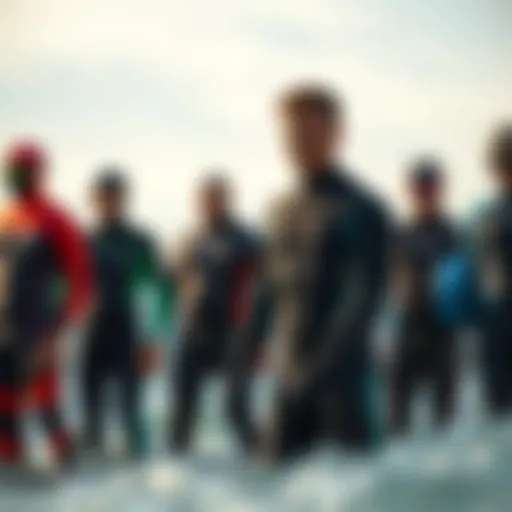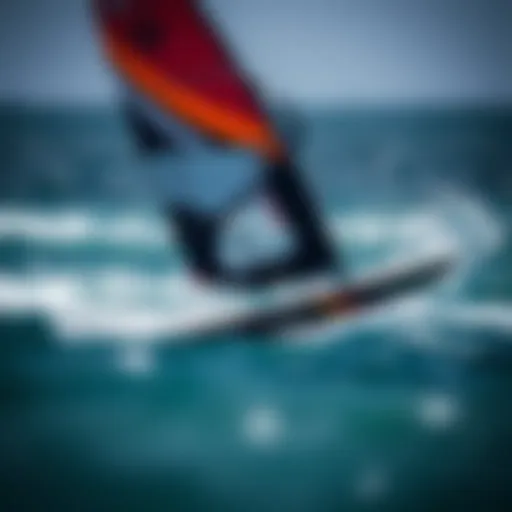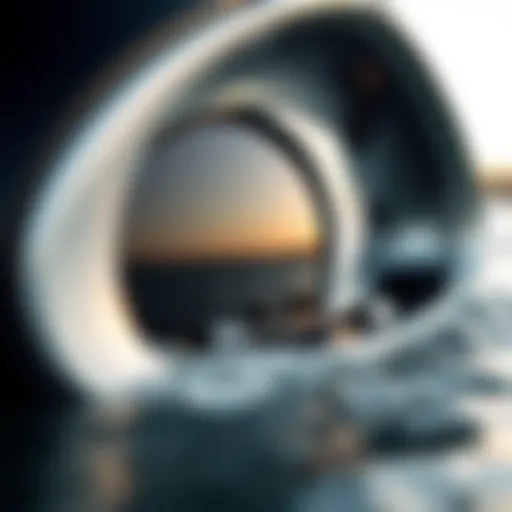Hydrofoil Market Insights: A Detailed Guide


Intro
The hydrofoil market is an intriguing segment of water sports, capturing keen interest from kiteboarding enthusiasts and those eager to ride the waves with innovation at their feet. As kiteboarding continues to evolve, hydrofoils have taken center stage, offering a unique experience that heightens speed and agility. This article aims to unravel the complexities of hydrofoils, from their varied types to their performance metrics, ensuring buyers can navigate this market with clarity.
As you paddle through the landscape of hydrofoils, you will encounter an array of options shaped by technological advancements. Understanding the specifics of each design, the materials utilized, and how they perform on the water are crucial for making a sound investment. Not to mention, as environmental consciousness grows, many are keen to explore eco-friendly choices within their purchases.
Let’s dive deeper into the techniques that can enhance your kiteboarding experience.
Techniques for Kiteboarding Enthusiasts
Beginner Techniques
For those new to kiteboarding, mastering the fundamentals is essential. Here are a few techniques to get you started:
- Body Positioning: Keep your center of gravity low and balanced to maintain control. When learning to hydrofoil, it’s vital to adjust your stance for optimal riding.
- Kite Control: Familiarize yourself with your kite. Practice launching, landing, and ensuring the lines are untangled.
- Water Start: Begin by positioning your board correctly in the water, aligning the kite at twelve o'clock to generate lift.
- Foil Board Balance: Finding your balance on the foil board is pivotal. Small shifts in weight will dictate lift, allowing you to ride effortlessly above the surface.
Advanced Maneuvers
Once you gain confidence in your skills, you can venture into advanced techniques:
- Jumping: Master small jumps by using the power of your kite. This involves timing your kite and board for maximum lift.
- Tack and Jibe: These maneuvers will help in changing direction more fluidly, adding to your overall control while riding.
- Transitions: Work on smoothly changing direction while maintaining speed, which is crucial when riding a hydrofoil.
"Water sports are like dancing with nature. The more you understand the rhythm, the better you perform."
Mastering these techniques will not only elevate your skills but also enhance your enjoyment on the water. Understanding the principles behind these techniques offers insight into the capabilities of hydrofoils and their adaptability to varying conditions.
Moving Forward
The knowledge of practical techniques is just the tip of the iceberg—an engagement with hydrofoil equipment will further enrich your kiteboarding endeavors. Understanding the right gear combined with knowing how to use it effectively is crucial. In the next section, we will delve into detailed equipment reviews that cater to both kiteboards and kites—ensuring you have the best tools at your disposal for a thrilling experience on the water.
Understanding Hydrofoils
Understanding hydrofoils is crucial for anyone looking to dive deeper into the realm of water sports. Hydrofoils provide a unique experience on the water, enabling riders to skim above its surface, which can lead to enhanced speed and reduced drag. Grasping the basics of hydrofoil technology not only allows for more effective use of these devices but also helps enthusiasts make better choices when purchasing or using them.
By comprehending the core principles of hydrofoils, riders can appreciate the innovation behind them and how they revolutionize the way we interact with water sports. This section details the physics behind hydrofoil technology, explores the different types of hydrofoils, and paves the way for a deeper understanding of their features and market positioning.
Moreover, this foundational knowledge is essential for kiteboarders and water sport coaches, as it equips them with insights necessary for teaching and selecting the right equipment. Here’s a closer look at both the physics and the various types of hydrofoils, which underpins the whole hydrofoil market.
The Physics of Hydrofoil Technology
Hydrofoils operate on principles rooted in fluid dynamics. When a hydrofoil is submerged in water and a force is applied, its shape creates a difference in pressure between the upper and lower surfaces. This pressure differential is what generates lift, allowing the hydrofoil to rise above the water surface, minimizing drag. The basic physics at play here is similar to how airplane wings function. The faster the hydrofoil moves, the more lift it generates, pulling the board (and rider) up into the air.
Key Points:
- Lift is generated by the pressure difference created by the foil's shape.
- Speed increases the lift, while also reducing drag.
- The design and angle of attack significantly influence performance.
In practical terms, understanding these principles aids kiteboarders when adjusting their riding technique for optimal performance on hydrofoils. Whether one is a beginner or seasoned rider, appreciating the physics enhances one’s ability to enjoy the exhilaration of hydrofoiling.
Types of Hydrofoils
When diving into the hydrofoil market, it’s essential to be aware that not all hydrofoils are created equal. Each type caters to specific riding styles and conditions, rendering this knowledge invaluable for selecting the right foil for your needs.
Surf Hydrofoils
Surf hydrofoils are typically designed for riding ocean waves. These foils often feature a more significant surface area that enables surfers to catch and ride swells with greater ease. A key characteristic of surf hydrofoils lies in their versatility; they perform exceptionally well across various wave conditions.
- Benefits: Surf hydrofoils are favored for their stability in uneven waters, making them a good choice for both beginners and seasoned surfers looking to maximize their time on waves.
- Unique Feature: They often include adjustable wings, allowing users to customize their ride based on wave height and type.
Kite Hydrofoils


Kite hydrofoils cater specifically to kiteboarding. They are engineered to provide control and stability, particularly in choppy waters where big kites can pull with great force. The main characteristic of kite hydrofoils is their narrow profile, which allows them to slice efficiently through the water.
- Benefits: Kite hydrofoils are often regarded as excellent for boosting performance and speed, making them popular among competitive kiteboarders.
- Unique Feature: Many models offer modular design elements, enabling customization for different riding styles or conditions.
Wake Hydrofoils
Wake hydrofoils stand out for their capacity to be towed behind boats. Designed to work with the wakes generated by speedboats, these hydrofoils can enhance the experience for wakeboarders. A primary aspect of wake hydrofoils is their focus on power and control aimed specifically at optimizing the riding experience behind a boat.
- Benefits: They provide thrilling lift and smooth maneuvers, ideal for those looking to get air off the wake.
- Unique Feature: Typically shorter than other hydrofoils, wake foils are engineered for quick turns and agile movements while being pulled by a boat.
Evaluating Hydrofoil Features
When it comes to hydrofoils, evaluating their features is as vital as choosing which shirt to wear on a first date; the right choice can make all the difference. Selecting a hydrofoil involves more than just picking a shiny new toy. It’s about understanding the mechanics that govern performance as well as how they align with your riding style and conditions.
Hydrofoils are intricate pieces of engineering. Not only do they lift the board above the water, significantly reducing drag, but their configuration determines responsiveness, speed, and control. Thus, dissecting features like wing shape and size, material, and mounting systems is crucial to ensure you indulge in a riding experience that doesn’t just meet but exceeds expectations.
Wing Shape and Size
The shape and size of hydrofoil wings influence overall ride qualities. Wider wings offer more lift at lower speeds. These are advantageous for beginners who might not have mastered speed yet. Meanwhile, narrower wings tend to provide sharper turns and high-speed performance, making them a go-to for advanced riders looking for agility. Wings must complement not just the rider's skill level but also cater to the type of riding one wishes to engage in, whether it's leisurely cruising or high-speed maneuvers.
Material Composition
Carbon Fiber
When it comes to lightweight construction and robust performance, carbon fiber reigns supreme. This material is famously known for its high strength-to-weight ratio, enabling the creation of foils that are not only lightweight but also immensely strong. The major characteristic of carbon fiber is its stiffness, which directly translates to stability during high-speed rides. Riders favor this material significantly due to its durability and resistance to flexing, allowing for efficient energy transfer and performance, especially in challenging gusts of wind.
One downside to carbon fiber is the price; it's often on the higher end which can deter entry-level buyers. Yet, its investment pays off with longevity and superb performance.
Aluminum
Aluminum is another material that deserves a conversation. While it may not be as light as carbon fiber, it is way more affordable, which can be a significant factor for many riders. Its flexibility makes it a good starter material, allowing for easier control and maneuverability. Aluminum's durability means it can handle an array of sea conditions without losing integrity quickly.
However, one must consider that aluminum isn’t as stiff as carbon fiber, which might lead to a less responsive ride during high-speed escapades. Consequently, it can be heavier on the water, affecting overall performance if not used rightly.
Wood
Amidst the high-tech options of carbon fiber and aluminum, wood still holds a nostalgic charm. The aesthetic appeal of wood can’t be overlooked; it carries a craftsmanship that resonates with many enthusiasts. Often praised for its buoyancy, wood tends to offer a unique riding experience.
However, potential buyers should note that while wood is great for casual riding, it is prone to water damage if not properly maintained, which could lead to complications in performance over time. Finding the right wood composition can also be a challenge since not all woods perform consistently across varied conditions.
Mounting Systems
The way the hydrofoil attaches to the board is far from trivial. A good mounting system can change everything about your ride. Typically, options may include plate mounts and tuttle systems, with each offering unique pros and cons. Consideration of compatibility with your board, ease of adjustment, and overall stability should weigh in when making your choice. When your commissioning this high-flying gear, remember: the right mount means a stable, enjoyable ride.
Market Trends in Hydrofoils
Understanding the market trends in hydrofoils is essential for anyone keen on making informed decisions in the water sports industry. Whether you are a kiteboarding enthusiast, an instructor, or a coach, recognizing these trends can directly influence your purchasing choices and ultimately enhance your experience on the water.
Growth of the Hydrofoil Market
The growth of the hydrofoil market is a phenomenon that cannot be ignored. Over the last few years, hydrofoils have surged in popularity among water sports enthusiasts, often described as the future of adventure on water. This growth is driven primarily by advancements in technology, which have made hydrofoiling more accessible and user-friendly. Performance improvements, like increased speed and decreased drag, have attracted both beginner and experienced riders alike.
Key factors contributing to this growth include:
- Innovation in Design: Brands are constantly refining hydrofoil designs, ensuring they cater to different skill levels.
- Increased Awareness: As social media spreads knowledge about hydrofoiling, more individuals are exposed to the excitement of this sport.
- Environmental Considerations: Hydrofoils typically have a smaller environmental footprint compared to traditional watercraft, appealing to eco-conscious consumers.
Consumer Preferences
Consumer preferences play a significant role in determining the direction of the hydrofoil market. Buyers today seek products that not only meet their performance needs but also align with personal values such as sustainability and brand reputation.
Performance vs. Cost


When discussing Performance vs. Cost, it's crucial to strike a balance. Enthusiasts want high-quality hydrofoils that deliver speed and stability without breaking the bank. Many options in the market offer impressive performance metrics but at a steep price. Therefore, understanding what you’re paying for is vital.
- Key Characteristic: Ideally, consumers expect affordable options that don’t compromise on performance.
- Benefits: By choosing wisely, buyers can ensure they get value for their investment; often, entry-level hydrofoils provide more than adequate performance for novices.
- Drawbacks: On the flip side, cheaper options may come with limitations, particularly in durability and material quality. This can lead to increased maintenance costs or early replacement.
Brand Loyalty
Brand Loyalty is yet another crucial factor influencing hydrofoil purchases. Once consumers find a brand that resonates with their values and performance needs, they are likely to stick with it. This loyalty can stem from positive experiences, rigorous product testing, or even community recommendations.
- Key Characteristic: Brand loyalty often translates to trust; consumers feel secure investing in what they know works.
- Benefits: Loyal customers may find themselves receiving better customer service, exclusive deals, or access to new products ahead of others.
- Drawbacks: However, this loyalty can blind consumers to superior alternatives or innovations from rival brands that may better meet their needs.
"Staying informed about market trends allows kiteboarders and enthusiasts to make educated decisions, aligning their purchases with evolving technology and personal preferences."
In summary, as the hydrofoil market continues to evolve, understanding its trends, including growth dynamics and consumer preferences, becomes paramount for anyone looking to enhance their water sports journey. By keeping tabs on these aspects, you position yourself to make smarter, more informed decisions about the hydrofoils you choose to invest in.
Buying Considerations for Hydrofoils
When diving into the world of hydrofoils, making an informed decision is crucial. This segment focuses on the various aspects one must consider before purchasing a hydrofoil. Understanding these considerations ensures that kiteboarders can select a hydrofoil that fits not just their budget but also their personal riding style and experience level.
New vs. Used Hydrofoils
Purchasing a hydrofoil can come down to the choice between new or used equipment. New hydrofoils generally come with the latest technology and warranties, meaning less worry about performance and durability. However, buying new could make your wallet feel a lot lighter.
Conversely, used hydrofoils can offer a more budget-friendly option. Many seasoned kiteboarders sell their old gear in good condition, allowing newbies affordable access. On the downside, buyers might face hidden repairs or parts that need replacing. Always consider the condition and history of the used hydrofoil before concluding.
Budgeting for Your Purchase
Budgeting is a cornerstone of the buying process. Understanding how much you can spend allows you to look at appropriate options.
Price Ranges
Price ranges for hydrofoils can vary widely, typically starting around $500 and going up to over $2,000 for premium models. The significant difference often lies in the materials and technology involved. For beginners, mid-range options offer a balanced approach to performance without breaking the bank.
This price variability reflects not just brand reputation, but also crucial features like wing size and shape. Opting for a hydrofoil within your budget can ensure you get value for your money. It's essential to compare similar features across different price brackets to find that sweet spot suitable for your style.
Value vs. Quality
Comparing value versus quality is also worth consideration. A low-price hydrofoil may seem tempting but can compromise durability or performance. On the other hand, spending more doesn't guarantee the best product either.
It's vital to look at factors like how often you ride and under what conditions. For frequent kiteboarders, investing in a higher quality hydrofoil could undoubtedly pay off in longevity and performance. However, casual riders may find that mid-range options hit the right notes without the premium price tag.
Where to Buy Hydrofoils
Finding the right spot to buy your hydrofoil can be just as significant as the choice of the hydrofoil itself.
Local Retailers
Purchasing from local retailers can enhance your buying experience. You have the chance to physically inspect the hydrofoil and ask questions directly to knowledgeable staff. Typically, you’ll find a selection tailored to your local riding conditions, which may help you choose a product that's best suited for your environment. However, local selection can sometimes be limited, and prices may be higher than online.
Online Marketplaces
Online marketplaces offer a vast selection of hydrofoils ranging from new to used, often at competitive prices. Websites like Amazon or specialized watersport shops can provide user reviews and ratings that help guide your final decision. Yet, online purchases come with their own risks; you cannot physically inspect the gear, and shipping costs may add to the overall price. Buying from reputable sellers and checking return policies are essential steps in this process.
Always conduct thorough research and cross-reference different sellers to ensure the best deal possible.
Hydrofoil Maintenance and Care
Maintaining your hydrofoil is crucial for extending its lifespan and ensuring optimal performance on the water. Just like any specialized equipment, hydrofoils require consistent care to perform at their best. Regular maintenance not only helps you avoid the headache of expensive repairs but also enhances your overall riding experience. The delicate interplay of materials, aerodynamics, and water dynamics in hydrofoils makes it all the more important to keep them in top form. Below, we’ll dive into essential cleaning and storage tips, along with common repairs and upgrades that can keep your hydrofoil riding smoothly and performing efficiently.
Cleaning and Storage Tips


Taking the time to properly clean and store your hydrofoil can seem tedious, but it pays off in spades. Here are some straightforward tips to help keep your hydrofoil in great shape:
- Rinse After Use: Immediately after coming off the water, rinse your hydrofoil with fresh water. This helps to eliminate salt, sand, and other debris that can cause corrosion or buildup over time.
- Inspect for Damage: During the rinse, take a moment to inspect your hydrofoil. Look for scratches or dents on the wings and fuselage. Early detection allows for quicker repairs before damages worsen.
- Dry Thoroughly: Use a microfiber cloth to dry the hydrofoil completely. Any residual moisture can lead to rust or mold if stored improperly.
- Proper Storage: Store your hydrofoil in a cool, dry place. Ideally, use a padded bag designed for hydrofoils. If you leave it out in the sun or damp areas, you're asking for trouble down the line.
- Avoid Stacking: If you have multiple hydrofoils, avoid stacking them on each other, which can misalign the wings or cause unwanted bends.
By implementing these simple care techniques, you’ll be setting yourself up for a much smoother riding experience in the long run.
Common Repairs and Upgrades
Even the most well-cared-for hydrofoil can encounter issues over time. Knowing how to spot these problems and upgrade your equipment can significantly enhance your ride:
- Small Dings and Dents: If you notice minor dings, use epoxy resin to fill them in. The repair process usually involves sanding down the surface for a smooth finish, then applying the resin.
- Wing Alignment: Sometimes, after repeated use, the alignment of the wings may become slightly off. A quick adjustment can restore your hydrofoil's optimal performance. Check that the wings are flat and parallel to the board.
- Foil Upgrades: If you're looking for even more performance, consider upgrading to a more advanced wing or fuselage. Newer models often incorporate better materials or designs that can improve efficiency and speed.
- Regular inspections: Make it a habit to conduct a thorough inspection before each ride. Look out for loose screws or hardware and ensure everything is tightened and secure.
"The secret to a great ride often lies in the details of maintenance and care. A little effort goes a long way in keeping your hydrofoil ready for action."
By keeping an eye on these aspects, you’ll not only prolong the life of your equipment but also elevate your overall riding experience. Regular maintenance may seem like a chore, but it is an investment in performance and safety that no kiteboarding enthusiast should overlook. For further details on maintenance best practices, you can check Wikipedia on Hydrofoil Technology and Kiteboarding Resource for community advice.
Environmental Impact of Hydrofoils
Understanding the environmental ramifications of hydrofoils is essential for manufacturers, consumers, and enthusiasts alike. This awareness guides not only purchasing decisions but also spearheads innovations aimed at reducing the ecological footprint of water sports. In a realm where sustainability is gaining traction, especially among passionate kiteboarders and water sports aficionados, it becomes increasingly vital to consider how each component of hydrofoil technology interacts with nature. Such considerations allow for a broader perspective on how hydrofoiling can harmonize with environmental stewardship.
Sustainability in Materials
The choice of materials used in hydrofoil construction plays a pivotal role in its overall sustainability. Modern hydrofoils often incorporate advanced materials like carbon fiber, aluminum, and even reclaimed woods. Each of these materials has its strengths and weaknesses in terms of durability, performance, and environmental impact.
- Carbon Fiber: While it offers superior lightweight characteristics and strength, the production process can be energy-intensive. Manufacturers are now exploring more eco-friendly alternatives or sourcing carbon fibers from recycled materials.
- Aluminum: This option boasts excellent recyclability. In the lifecycle of hydrofoils, aluminum can be broken down and repurposed with relative ease, presenting a lower environmental impact compared to non-recyclable materials.
- Wood: Utilizing sustainably sourced wood can significantly reduce the carbon footprint of hydrofoils. The natural aesthetic and flexibility wood provides also cater to enthusiasts who appreciate the craftsmanship involved in their gear.
By emphasizing sustainability in materials, hydrofoil makers are paving the way for eco-friendlier designs without sacrificing performance. More manufacturers are beginning to realize that choosing materials responsibly not only favours the planet but also aligns with the expectations of a conscientious consumer base.
Effects on Marine Life
Another focal point in the environmental discussion around hydrofoils is their impact on marine ecosystems. As hydrofoiling gains popularity, navigating the waters responsibly becomes paramount. It is pivotal for kiteboarders to understand how their activities can affect sea life.
First and foremost, the noise pollution generated by hydrofoils can disrupt the delicate balance of aquatic environments. Many fish and marine mammals rely on sound for communication and navigation. The whir of a hydrofoil can interfere, inadvertently threatening delicate ecosystems.
Moreover, hydrofoils generate lift that can cause disturbances in water flow patterns. This alteration can impact the habitats where fish and other marine creatures breed and feed. Thus, choosing calmer, less trafficked waters for hydrofoil activities can mitigate these risks. Ultimately, being mindful of one’s riding environment signals respect for marine life and the ecosystems that thrive there.
"Sustainable practices are not merely a trend; they are a commitment to ensuring that generations to come can enjoy the beauty of nature as we do today."
In summation, understanding the environmental impact of hydrofoils is not just about complying with regulations or ticking off a checklist for sustainability. It’s about embracing a lifestyle that harmonizes adventure with ecological mindfulness. As kiteboarding enthusiasts embrace this awareness, it can lead to a more sustainable future for water sports, preserving the allure of our oceans for future riders.
Integrating Hydrofoils into Kiteboarding
Integrating hydrofoils into kiteboarding is more than just a trend; it's reshaping the entire experience on the water. Kiteboarding, traditionally characterized by its full-throttle, adrenaline-pumping style, has found a fresh twist with the introduction of hydrofoils. These innovative devices lift the rider above the water's surface, significantly altering dynamics such as speed, agility, and maneuverability. This section dives deep into how hydrofoils complement kiteboarding, the benefits they bring, and considerations for those ready to embrace this new chapter in water sports.
Techniques for Beginners
Getting started with hydrofoil kiteboarding can be a tad daunting — but don’t fret! With the right approach and techniques, even those new to kiteboarding can find their footing. Here are some tips tailored for beginners:
- Start with Familiar Gear: It’s best to first get comfortable with standard kiteboarding before transitioning to a hydrofoil setup. This way, you’ll have a solid grasp on kite control.
- Choose the Right Location: Find a flat, calm water body to practice. Wind conditions should be steady but not too strong. It’s important to avoid turbulent waters, especially when you’re still learning.
- Adjust Your Equipment: Make sure your hydrofoil and kite are sized appropriately for your weight and skill level. A larger kite can give you more lift and stability.
- Focus on Balance: Initially, concentrate on maintaining balance. Keep your knees slightly bent, and your weight centered over the foil. This balance will be key as you start building speed.
- Practice Kite Control: With the hydrofoil in the water, practice steering your kite. Learning how to keep it stable will be crucial before you attempt any tricks or jumps.
- Progress Slowly: Start by simply flying the foil in the water and gradually work up to getting airborne. Remember, it’s about gradual progression; don’t rush!
As you embark on this journey, remember to keep a positive mindset. Falling is part of the learning process; each splash brings you one step closer to mastering the hydrofoil!
Advanced Riding Strategies
Once you've gotten the hang of the basics, it's time to step up your game. Advanced riders often search for ways to refine their skills and increase their performance on the hydrofoil. Consider the following strategies:
- Jumps and Tricks: With more experience, you can begin experimenting with jumps. Maintain an even pull on the kite as you take off — timing is critical!
- Riding in Different Conditions: Gain versatility by practicing in varying wind conditions. Transitioning from light to moderate winds can significantly enhance your control and adaptability.
- Mastering Transitions: Work on smooth transitions from toe-side to heel-side and vice versa. This skill often separates good riders from great ones, allowing for fluid movements and improved flow.
- Utilize the Harness: Don’t forget your harness when riding. In advanced maneuvers, relying on it can save energy and provide better control over your movements.
- Start small with basic jumps before tackling more complex maneuvers like 360s or back rolls.
"Mastering the hydrofoil is about finding harmony between your body, the board, and the kite. The true beauty of hydrofoil kiteboarding lies in that balance."
- Trial Different Foils: As you progress, experiment with different types of hydrofoils. Each setup will respond differently, affecting speed, lift, and handling. Make adjustments based on your style and preference.
Integrating hydrofoils into your kiteboarding routine adds a layer of excitement and innovation, transforming not just how you ride but also your overall experience on the water. By honing your skills and experimenting with various techniques and strategies, you can take your hydrofoil kiteboarding to exhilarating new heights.
For more detailed guides and community discussions, check out reddit.com/r/kiteboarding or explore equipment options at kiteforum.com.















